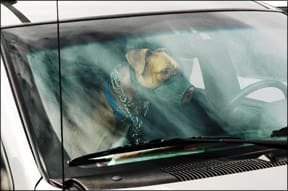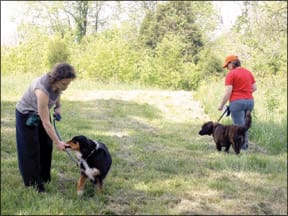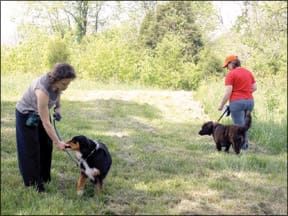[Updated October 18, 2018]
Aggression. It’s a natural, normal dog behavior, but it’s also a scary word that evokes images of maulings and dog-related fatalities. The term “aggression” actually encompasses a long continuum of behaviors, some of them very appropriate and critically important to successful canine communication. If your dog has ever displayed the slightest sign of aggressive behavior, it is incumbent on you as a responsible owner to learn as much as possible about the causes of – and of course, solutions for – canine aggression.
Photo by Penelope Brown

The Scope of Aggressive Dog Behaviors
The broad spectrum of “aggressive behaviors” is technically called “agonistic behavior” and is defined in ethology as, “pertaining to the range of activities associated with aggressive encounters between members of the same species or social group, including threat, attack, appeasement, or retreat.” So, while a growl-lunge-bite sequence would be easily recognized by most people as aggression, more subtle agonistic behaviors such as a freeze, a hard stare, or even a lack of eye contact, may go unnoticed (and unaddressed).
Aggression is probably the most common behavioral problem in dogs seen by behavior professionals and the most dangerous one seen in companion dogs. While the number of dog-related fatalities (about 30 per year in the U.S.) pales in comparison to accidental death by other means, the number of annual reported bites is staggering. According to the Dog Bite Law website: “The most recent official survey, conducted more than a decade ago, determined there were 4.7 million dog bite victims annually in the U.S. A more recent study showed that 1,000 Americans per day are treated in emergency rooms as a result of dog bites. Dog bite losses exceed $1 billion per year, with over $300 million paid by homeowners insurance.”
Cultural Shifts and Dog Aggression
In my opinion, our culture has become oversensitized to dog bites. Once upon a time, if a kid was bitten by a neighbor’s dog, his mom generally asked the kid what he was doing to the dog that he shouldn’t have been. Today she reaches for the phone to call her attorney, or, if it’s her dog, dialing up a behavior professional, or worse, dropping the dog off at her local shelter. We’ve turned into a nation of aggress-a-phobes.
Behavior professionals mull over the causes of what looks to be a huge and growing problem. Theories about the contributing factors abound:
- The population shift away from rural living and toward urban and suburban homes may have lessened our general understanding of animal behavior.
- This lack of understanding manifests as inappropriate human behavior toward dogs, which triggers more aggressive behavior, as well as a lower tolerance for bites – even minor ones.
- A more responsible dog-owning population keeps dogs at home, rather than letting them wander, and as a result dogs may be less socialized – and more likely to bite (see “Light Bite,” WDJ June 2010).
- There has been an increase in popularity of dog breeds that contribute to our cultural sensitization – large, powerful breeds who can do serious damage if they bite, such as Pit Bulls and Rottweilers – as well as breeds who are sensitive to violations of their personal space and have a lower tolerance for inappropriate human behavior, such as Border Collies and Australian Shepherds.
- Finally, the appropriately diligent efforts of animal control authorities to quarantine dogs who bite (for rabies control purposes) and craft dangerous dog laws (for public safety purposes) have probably fueled the alarmist reactions to even minor dog bites.
I’m not saying aggression isn’t a serious behavior. But there’s aggression, and then there’s serious aggression. In a perfect world, all humans would recognize and take appropriate action at the lower levels of agonistic behavior. If that happened, we would rarely see serious aggression – in fact we’d rarely see any bites at all. Until that time, we can only work, one dog and one human at a time, to expand human understanding of canine aggression.
Stress in Dogs
Across the board, with one tiny exception so rare it’s barely worth mentioning, aggression is caused by stress. Whatever “classification” of aggression an owner or behavior professional chooses to use, the underlying cause of the aggression is stress. There is usually a triggering stressor; when a dog bites a child, it’s a good bet that child was a stressor for him – but there is also a background noise of other stressors that pushed the dog over his bite threshold with that child on that particular day. These may be stressors that we don’t even notice. And because cortisol, a stress hormone that plays a role in aggression, can stay in the system for at least two days, they can be stressors that occurred yesterday, or even the day before!
Think of it as canine road rage. In humans, road rage might look like this:
- Stressor #1: Our subject jumps out of bed in the morning realizing that his alarm didn’t go off and he’s late for work.
- Stressor #2: He dashes through a cold shower because his hot water heater is on the blink.
- Stressor #3: As he hurries out the door his eye falls on the foreclosure notice that arrived in yesterday’s mail because his mortgage payment is overdue.
- Stressor #4: He jumps in his car, starts the engine and sees that his gas gauge is on “E.” He’s already late and now he has to stop to get gas.
- Stressor #5: As he pulls onto the freeway his cell phone dings to remind him of an important meeting in 15 minutes – and his commute is 25 minutes.
- Stressor #6: He remembers that his boss warned him that if he’s late for one more important meeting he’ll be fired. If he speeds, maybe he can make it.
- Stressor #7: Traffic is a little slow, but if he uses the commute lane, maybe he can make it. Just as he starts to pull into the lane a car cuts him off and then pokes along in front of him below the speed limit. It’s the last straw. Over threshold, he reaches under his seat pulls out his loaded .357 and . . .
In dog, canine road rage might look like this:
- Stressor #1: The dog has a little isolation distress, usually mitigated by the presence of his canine sibling, but today his brother got dropped off at the vet hospital when his humans went off to work, so he’s all alone.
- Stressor #2: A UPS delivery arrives, and dog has a “thing” about delivery people.
- Stressor #3: Just before noon a thunderstorm passes through. The dog is thunder-sensitive, and owner didn’t give him his thunder medication this morning.
- Stressor #4: Pet walker is supposed to arrive at 1 pm, but is late and doesn’t get there until 2:30. Dog is stressed by change in routine and by urgency of a very full bladder by the time the walker arrives.
- Stressor #5: Humans arrive home at their normal time but they are stressed because there are dinner guests due at 7 pm and they have to get ready. Dog is stressed by his humans’ stress, and the fact that they rush though his evening routine, feeding him hurriedly and skipping his walk to the dog park for exercise.
- Stressor #6: Visitors arrive, and while the dog is fine with adult visitors, he is not especially fond of children, and there are four in this family. All through dinner, the dog hears the high-pitched children’s voices laughing and arguing, and he occasionally sees them staring at him.
- Stressor #7: After dinner the kids are running around the house. The dog tries to stay out of their way, but eventually one corners him in the kitchen. Over threshold, he pulls out his loaded mouth and . . .
Stress is an emotional and physiological response to a stimulus. The foundational underpinning of aggression is based on classical conditioning; your dog’s emotional and physical response to a stimulus that causes him stress: fear, pain, anger, and/or some other strong emotion. He can’t help his emotional response any more than you can when faced with something that scares or hurts you.
Aggression also has an operant component; your dog learns that he can deliberately act to make scary stressors go away. When he growls, barks, and lunges, perceived bad things tend to leave – so his aggressive behavior is negatively reinforced (dog’s behavior makes a bad thing go away), and increases over time.

Dog Aggression is NOT Dominance
There’s a widespread misconception held by many dog owners, perpetuated by unfortunate television drama, that aggression is all about dominance, and that the appropriate response to any display of aggression is to force the dog into submission. This couldn’t be further from the truth. In fact, a very mild, easily resolvable display of aggressive behavior can quickly become a significant behavior problem if the dog’s human responds with aggression.
The concept of dominance in a social group has been so widely misunderstood and distorted that many knowledgeable behavior professionals hesitate to even use the term. In fact, dominance has little to do with aggression, and a lot to do with access to desired resources: the concept of dominance strictly refers to an interaction or a series of interactions between two individuals in which there is an outcome in favor of one member of the pair.
That outcome is largely determined by a submissive or yielding response from one of the individuals and not through overt conflict or escalated aggression. Someone who is truly higher ranking in social status doesn’t need to resort to aggression to get what he wants. Violent behavior between group members is inappropriate and unacceptable in social interactions. These precepts hold true for social groups of all species, including humans.
Using violent behavior against a dog who is aggressive adds additional stress to his stress load. With force, you may be able to suppress his aggressive behavior in that moment. However, your actions will increase the probability of his future aggression – and possibly more intense aggression. There are far more appropriate and effective ways to manage and modify aggressive behavior than aggressing back.
Aggression-Modifying Action Plan
So what do you do when your dog exhibits aggressive behavior? Remember that stress, not any desire to take over the world, causes aggression to erupt. The first thing to do is educate yourself about dog body language so you can be aware of your dog’s more subtle agonistic behaviors. (See “Signs Your Dog Has Stress,” June 2006.) Then be aware of your dog’s stressors and stress levels, and avoid putting him in situations where he may be compelled to bite. When you do see stress signals, even subtle ones, remove him from the immediate proximity of the stressor to help him cope with the situation.
When you’ve identified something that appears to be a stressor for him, figure out how to remove it as a stressor in his life. If it’s something you can get rid of, simply get rid of it. If you can manage it, by removing the dog from the environment when you know the stressor will be present, do it. If it’s too present in his world to get rid of or manage, take steps to change his opinion of that stressor through counter-conditioning, or change his behavior in the presence of that stressor through operant conditioning.

There are bound to be some low-level stressors that he’ll just have to live with. As long as they aren’t significant enough to put him near or over his bite threshold, he can live with some stressors. We all have some stress in our lives!
Here are some examples:
- Get rid of it: Anything aversive that causes unnecessary pain or stress, including shock, choke, and prong collars; penny cans; or throw chains. Even head halters, considered by many to be positive training tools, are aversive to some dogs.
- Manage it: So, your dog isn’t fond of small children and there are none in your life and he doesn’t encounter them regularly in your neighborhood. Even so, you can manage him the one time each year your sister comes to visit with your young niece and nephew, by keeping him in another part of the house when the kids are awake and about.
- Change his association: Convince him that something that stresses him is actually very wonderful by pairing it consistently with something else wonderful. If your dog is stressed by men with beards, you can convince him that men with beards always make chicken happen, by having a bearded man appear, and feeding bits of chicken to your dog, over and over and over again, until he wants furry-faced men to appear so he can have more chicken.
The key to successful counter-conditioning, as this process is called, is to always keep the dog below threshold; you want him a little aware of and worried about the aversive stimulus, but not quaking in fear or barking and lunging.
- Teach him a new behavior: Perhaps your dog becomes highly aroused by visitors coming to the door. He’s not fearful or aggressive, but the high arousal is a stressor. You can teach him that the doorbell is his cue to run get in his crate, where he’ll receive a stuffed Kong or other doggie delectable. (See “Unwanted Barking at the Front Door,” February 2010.) Or you can teach him that visitors toss toys for him to chase if he sits politely when the door opens.
- Live with it: So you’re a little (or a lot!) stressed because your work isn’t going well, or the school just notified you that your teen-age daughter has been skipping school. While I encourage you for your own well-being to take steps to reduce your own stress as much as possible, this is one your dog can live with, especially if you remember that when you are stressed, it pushes your dog a little closer to his own bite threshold.
When Your Dog Does Bite
What if you misjudge a situation and something happens that puts your dog over threshold and causes him to display seriously aggressive behavior, perhaps even bite? First, don’t panic. All dogs can bite, and the fact that yours has doesn’t make him a Cujo. You will need to:
- Move him away from the scene. Stash him in another room, stick him in your car for a moment, or hand his leash to someone he knows who is not at risk for being bitten and have them take him away.
- Apologize. A good apology is, “Oh, I am so sorry you were bitten! (or your dog was bitten, or your child was bitten).
- Examine the bite site. Take a couple of quick photos if you can. If the bite broke skin, offer first aid (if you have it). If the injuries are serious, make sure that the victim has a way to access medical care.
- If it’s clear that your dog was the sole offender, you may want to offer to pay for medical or veterinary care. A pre-emptive discussion with your attorney about this possibility is a good idea, to prevent yourself from taking on more liability than is appropriate, while still doing the ethical and reasonable thing. If it’s unclear who “started it,” be wary of immediately accepting responsibility for the incident.
- Prepare for a visit from animal control. In most of the country, if a dog bite breaks human skin, the dog must be quarantined for at least 10 days. Have your current rabies certificate handy – they will ask to see it; a rabies tag isn’t enough.
In many jurisdictions you may be able to quarantine your dog in your own home. If not, find out if your dog can be kept at a vet hospital for the required period; it’s usually a safer, less stressful place than a shelter.
If animal control insists on taking your dog away for quarantine, do not sign anything until you have read it carefully and are sure you understand it. Some dog owners have unknowingly and tragically signed their dogs over for euthanasia when they thought they were just agreeing to quarantine.
- Prepare for “dangerous dog” legal proceedings. Depending on the laws in your area, your dog may be declared “potentially dangerous” for acting aggressively, or “dangerous” for actually biting someone. It’s good to read your local ordinance now, even if your dog never bites anyone, and for sure after a bite happens. If your dog is designated dangerous or you do get called to a hearing of some kind in relation to your dog’s aggressive behavior, you’d be wise to involve your attorney.
Bite Prevention
Basic training and early socialization can go a long way toward inoculating your dog against future aggression. Your observational skills and ability to mitigate stressful situations for your dog are excellent booster shots. At the point, however, when you become aware that your dog’s behaviors are inappropriate, traveling along that continuum of agonistic behavior verging on overt aggression, and are resistant to your efforts to manage and modify them, it’s time to call for help.
Remember that a good behavior professional won’t come riding in like a white knight, push your dog around a little, and declare him cured. A good behavior modification protocol is not dramatic, but rather a slow, low-key program that will help your dog learn to better cope with his world.
Your behavior professional won’t need to see the actual aggressive behavior; she will trust your description of your dog’s reaction to the stressors in his world, and help you figure out how to keep him far below his bite threshold. Like most behaviors, aggression is far easier to modify sooner, before your dog has had time to practice and get good at it.
Counter-Conditioning for Aggressive Dogs
This technique involves changing your dog’s association with a scary or arousing stimulus from negative to positive. The easiest way to give most dogs a positive association is with extremely high-value, really yummy treats. I like to use chicken – canned, baked, or boiled, since most dogs love chicken and it’s a low-fat food. Here’s how the process works:
1. Determine the distance at which your dog can be in the presence of the stimulus and be alert or wary but not extremely fearful or aroused. This is called the “threshold distance.”
2. With you holding your dog on leash, have a helper present the stimulus at threshold distance X. The instant your dog sees the stimulus, start feeding him bits of chicken, non-stop. (Note: If your dog is too excited to eat the chicken, then you have the stimulus too close. Back it way up until your dog is calm enough to take the chicken, but still notices the stimulus.)
3. After several seconds, have the helper remove the stimulus from your dog’s sight, and stop feeding the chicken to your dog.
4. Keep repeating those first steps until the presentation of the stimulus at that distance consistently causes your dog to look at you with a happy smile and a “Yay! Where’s my chicken?” expression. This is a “conditioned emotional response” (CER). Now your dog’s association with the stimulus at threshold distance X is positive instead of negative.
5. Next you will increase the intensity of the stimulus. You can do that by decreasing the distance between your dog and the stimulus; by increasing the movement of the stimulus at distance X (if the stimulus is a child, for example, ask the child to skip or swing her arms); by increasing the number of stimuli (two or three children, instead of one); increasing the visual “threat” (a tall stranger instead of a short one, or a man with a beard instead of a clean-shaven man); or by increasing the volume (if it’s a stimulus that makes noise, such as a vacuum cleaner).
I’d suggest decreasing distance first in small increments by moving the dog closer to the location where the stimulus will appear, with your dog achieving the intended CER at each new distance, until your dog is happy to be very near to the non-moving stimulus, perhaps even sniffing or targeting to it.
6. Then return to distance X and add intensity of your stimulus (move the vacuum a little; have two children instead of one; have the man put on a hat, or a backpack), gradually decreasing distance and attaining CERs along the way, until your dog is delighted to have the moderately intense stimulus in close proximity.
7. Now, back to distance X. Increase intensity again, by having your helper turn the vacuum on briefly (while you feed treats the instant it’s on). Then turn it off and stop the treats. (Or turn up the volume, or add more children, etc.)
8. Repeat until you have the CER, then gradually increase the length of time you have your dog in the presence of the increased-intensity stimulus, until he’s happy (but not aroused) to have it present continuously.
9. Begin decreasing distance in small increments, moving the dog closer to the stimulus, consistently obtaining the desired CER from the dog at each new distance.
10. When your dog is happy to have the higher-intensity stimulus close to him, he’s ready for the final phase.
11. Return to distance X and obtain your dog’s CER there, with a full intensity stimulus – a running, moving vacuum; multiple children laughing and playing; a tall man with a beard wearing a hat, sunglasses, and a backpack. Gradually decrease the distance until your dog is happy to be near the full-intensity stimulus. He now thinks the stimulus is a very good thing, a reliable predictor of very yummy treats. In the case of a human stimulus, you can gradually work up to actual interaction with the human(s) at this stage, by having the person(s) drop treats as they walk by, then letting your dog take treats from their fingers – without direct eye contact, and eventually working up to normal interaction.
The more complex the stimulus and more intense the fear or arousal response, the more challenging it is to modify the behavior. Anxieties and phobias generally require a great commitment to a long and in-depth modification program.
Pat Miller, CPDT-KA, CDBC, is WDJ‘s Training Editor. Miller lives in Fairplay, Maryland, site of her Peaceable Paws training center. Pat is also author of several books on positive training, including her latest: Do Over Dogs: Give Your Dog a Second Chance for a First Class Life.






